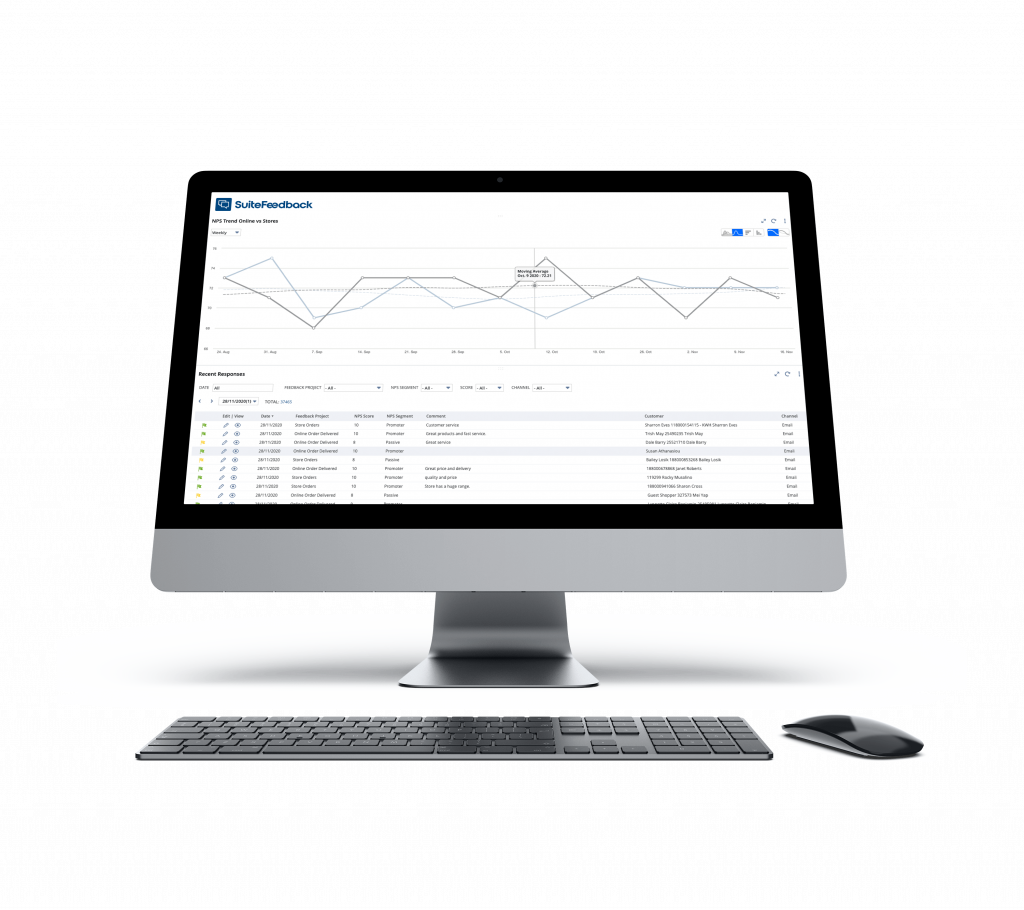Taking good care of your customers is critical to business success. Yes, this is common sense, but many business owners underestimate the financial impact of keeping customers happy. Research shows that bringing on a new customer costs five times more than retaining an existing customer. Plus, improving your retention rate by just 5% can boost profits by as much as 95%.
The secret to winning long-term fans is listening to customer feedback and taking action as needed. This requires a centralized feedback program like the Net Promoter System that allows you to tap into your customers’ thoughts and opinions so you can better deliver products and services that meet their needs and quickly take action to solve their challenges.
Taking the pulse of customers is the only way to ensure amazing customer experiences and positive word-of-mouth marketing, both of which are increasingly important in the e-commerce era. In fact, shoppers are more likely to trust recommendations from people they know than traditional marketing campaigns.
Closing the Loop
The Net Promoter Score (NPS) can help you keep tabs on customer satisfaction. Widely used in customer experience programs, the Net Promoter System measures customer loyalty by asking one simple question: “How likely is it that you would recommend our company to a friend or colleague?” Based on the answer, which can range from 0 (not at all likely) to 10 (extremely likely), respondents are labeled a promoter (a score of 9-10), passive (7-8), or a detractor (0-6).
So paying attention to NPS is good. But what’s not so great is that many businesses run a survey, get a score, and that’s the end of it. If NPS is OK, they’re OK. The reality is that NPS is a meaningless metric unless you understand what’s behind the score and have the right tools to manage and take action on it. This is called “closing the loop” and is the essential piece missing from many customer feedback programs.
There are a few reasons companies neglect to close the loop. Some realize the benefit of taking this step but don’t know where to start. Others are simply ignorant of the value of customer feedback. Perhaps their sales are already high, so they assume customers are happy and leave it at that.
The biggest problem, however, is that companies are at a loss for how to centralize the data. They have siloed feedback portals for different areas of the business and collect feedback without any real plan for acting on it. This is a mistake because the real magic happens when you can synthesize data from customers at every point of the buyer’s journey and through multiple forms of communication. And for that, you need a centralized management system. SuiteFeedback in NetSuite takes care of this.
Closing the Feedback Loop
The investment of time, effort, and money to close the feedback loop is well worth it because customer feedback can tell you so much more than whether customers are happy with your business. Done well, it provides an avenue for free word-of-mouth advertising, information to help you improve your offerings and insights into new products or services your customers would be eager to take advantage of.
To truly close the loop, you have to:
- Identify “moments of truth” at every stage of the buyer’s journey.
- Have a system for smartly and strategically acting on the feedback.
- Let customers know you have heard their feedback.
- Use the customer’s voice to inform strategy and decision-making.
To start, you must have a goal in mind. Don’t just collect feedback aimlessly. Your goal will guide the questions you ask your customers and will be unique to your business. Examples of common objectives include understanding trends in customer satisfaction, identifying snags in customer service, and discovering product flaws.
The feedback process should be made as painless as possible for customers. Make it simple and quick with clear directions. You’ll also want to give them multiple avenues for sending feedback. Emails, chats, pop-up surveys, and social media comments are all reasonable options. Include the customer’s name to make the process feel personalized. Finally, be sure to tell customers how much you value their feedback and how it will be used.
Customize Responses to Feedback
On the most basic level of closing the feedback loop, once you have the NPS for customers, you should be taking specific action for promoters, passives, and detractors. For your biggest fans — your promoters — send them a link to review your company on social media, Google, or Trustpilot, and publish their kind words on your website.
In recognition of their positive feedback, give them access to special sales or deals, provide referral discounts for sending you new customers, or send them a gift card. The options for expressing your gratitude (and encouraging more feedback and word-of-mouth marketing) are endless.
For unhappy customers — your detractors — follow up through an email or phone call to get to the bottom of their negative experience. You’ll want to learn directly from them what can be improved and possibly even convert them into a passive or promoter.
You’d be surprised how far staying engaged and demonstrating eagerness to solve customers’ problems can go toward winning them over. That said, you don’t want to waste time tracking down a one-on-one communication with every single detractor — some people just like to complain. You’ll have to create your own. SuiteFeedback gives you the system for knowing which detractors to follow up with.
Finally, you’ll want a plan for quick action when you see that a promoter is losing enthusiasm for your brand or has had a less-than-stellar experience. Say, for instance, a customer in your top 10% lifetime value segment becomes a detractor. Opening a support ticket and treating this person like any other detractor won’t cut it. One way of handling this scenario is to notify the CEO so he or she can call the customer directly to discuss the issue and ask for an explanation. This makes the customer feel important and gives you your best shot at moving him or her back into promoter territory.
In short, a one-approach-fits-all response to feedback closes you off from a lot of valuable information and opportunities to build deeper relationships with customers.
Tools to Enhance and Encourage Customer Feedback
Reaching customers through a variety of channels and at every step of the buyer’s journey and beyond is a lot to juggle, but SuiteFeedback can make it simple. It links together data from customers, the market, and even employees to produce a holistic picture of how your business is performing, what customers really think, how they behave, and how happy they are with your product or service.
Knowing your goal before you start asking customers to give you feedback is key. Otherwise, your data will essentially be useless and won’t help you improve and refine your products, processes, and customer service.
Your goal will also determine the questions you ask and when you ask them. In general, however, you’ll want to reach out to customers beginning 24 hours or less from purchase. This sets the stage for a long-term relationship between your brand and the individual. You’ll also want to periodically reach out to different customer segments for feedback — many companies do this via an annual customer satisfaction survey.
Finally, your customer feedback system should track satisfaction levels via monthly or quarterly surveys. This lets you know whether happy customers stay that way.
An Integrated System Can Understand Your Needs and Goals
Requesting feedback throughout the entire buyer’s journey and through multiple channels provides a lot of actionable data — often way too much for companies to know how to effectively manage it. It’s easy to get overwhelmed and for the data to become an indecipherable mess. Moreover, any trends or strategic value gets lost in the noise. This is where an integrated system comes into play.
An integrated system is a powerful tool that can understand your goals and can collect feedback data, organize it in one centralized location, and uniquely report on it. This simplifies, streamlines, and optimizes the entire process. What’s more, by tying the system to your customer and transaction records, the data and processes necessary to manage it are easily integrated into your team’s workflow. It can also reach out to your customers, containing literally the entire process in one package.
Here’s just a small sample of what an integrated system can reveal: the actions customers took, where they came from, how long they browsed your website, what content they read, how satisfied they are, which customers are unhappy, and so on. Competition is fierce in the business world, so you can imagine how having this information could help you gain an edge over your customers’ other options.
Why SuiteFeedback Is NetSuite’s Other Half
SuiteFeedback is a cutting-edge integrated customer feedback system that automates your feedback processes and puts your customers front-and-center in your business. The service has been specifically designed for NetSuite customers to gather customer feedback using NPS. NetSuite is a cloud computing company that provides services and software to manage business operations, finances, and customer relations.
Customer experience has always been important, but never more so than today. According to a Walker study, the customer experience will surpass product and price as the key brand differentiator by the end of 2020.
In other words, dialing into your customer service is the best path to business success. Request a demo todayto learn how SuiteFeedback can supercharge your customer feedback processes and help you retain your biggest fans.




